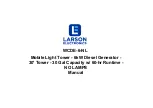
©
2010 Magnum Energy, Inc
Page 35
Installation
2.6.3
Neutral to Safety Ground Bonding
The recommended standards for safely wiring mobile and marine installations require that the
neutral and safety ground be connected at the AC source; whether it is an inverter, shore power,
or a generator. This is to establish a speci
fi
cation that maximizes the possibility that a circuit
breaker will activate if a hot-wire-to-ground fault occurs. These standards also require that the
AC neutral be connected to safety ground (often called a “bond”) in one, and only one, place at
any time. The single bond is established in order to make the electrical panel’s neutral line safe,
by connecting it to ground. Without this bond, the neutral can have up to 60 VAC with respect to
ground. On the other hand, if more than one bond is established, currents can circulate between
neutral and ground and cause “ground-loop” currents. These ground-loops can trip GFCIs, cause
an electric shock hazard, and may be the reason for other annoying side effects.
In applications where you are using an inverter as one of your AC sources along with another
AC source (e.g., shore power or generator) there is the potential of having multiple connections
(bonds) between neutral and ground. Therefore, you must ensure that the inverter does not also
connect the neutral-to-ground while the other AC source is actively powering the inverter loads.
This can be prevented if your inverter is equipped with automatic neutral-to-ground switching.
WARNING:
In most electrical systems, the neutral-to-ground bond is located in the
main shore power service entrance panel. Remove any bond downstream from the
inverter to prevent multiple bonds. If there is an inverter sub-panel — separate from a
main electrical panel — it should have a removable wire that allows the neutral bus to
be unbonded from the ground busbar.
All ME Series inverter/chargers have automatic neutral-to-ground switching to speci
fi
cally work
in multiple source applications. The ME Series inverters use an internal relay that automatically
connects the AC neutral output terminal to the vehicle/boat’s ground while inverting (Inverter
Mode) to provide the neutral-to-ground bond; as shown in Figure 2-18. However, when an external
AC source (e.g., shore power or a generator) is quali
fi
ed, another neutral-to-ground connection is
introduced in the system. When the ME Series is connected to this external AC source and goes
into Standby Mode, the internal relay automatically opens the neutral-to-ground connection, as
shown in Figure 2-19. This design keeps two neutral-to-ground connections from occurring at the
same time, thereby preventing an electrical shock hazard between the vehicle/boat’s neutral and
the external AC source’s neutral.
GR OU N D
N eu-Gnd R elay
(K1)
N EU T IN
In sid e M E S e rie s In ve rte r /C h a rg e r
(In ve rte r M o d e)
N EU T OU T
GR OU N D
N eu-Gnd R elay (K 1)
N EU T IN
In sid e M E S e rie s In ve rte r/C h a rg e r
(S ta n d b y M o d e)
N EU T OU T
Figure 2-18, Neutral-to-Ground
Connection (Inverter Mode)
Figure 2-19, Neutral-to-Ground
Connection (Standby Mode)
















































